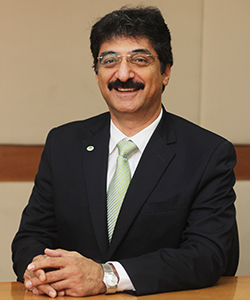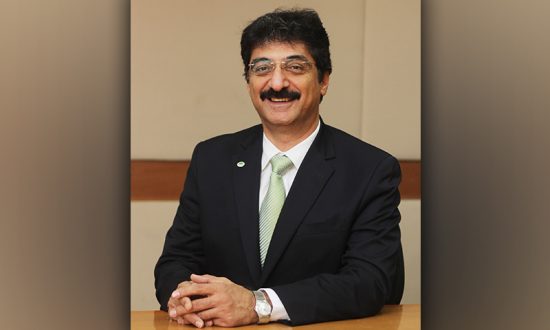Despite the advice from Government and media to use contactless transactions during the COVID time, many banks have higher levels of ATM usage as customers withdraw cash more than usual rate. “With low ATM penetration in the country, how can it serve financial inclusion? For that, we need high ATM penetration. We feel that ATMs, with its innovative technology, can serve as an essential digital touchpoint for the masses,” says Rustom Irani, MD & CEO of Cash Business Unit, Hitachi Payment Services. In an email interaction with CXO Outlook, Rustom Irani talks about the impact of COVID – 19 and lockdown on customers in terms of cash withdrawal, challenges faced by ATM operators in replenishing and managing ATMs in the ongoing situation, the future outlook of ATM industry in India and many more. Excerpts.
In this time, when everyone is advised to have contactless payments, what is the need for ATMs in the payment ecosystem?
The Indian payments industry has witnessed remarkable growth, innovation and regulatory support over the last few years, and the evolution of the digital payments ecosystem in India has been particularly noteworthy. At the same time, cash withdrawals from ATMs have increased over the past five years. As per RBI data for 2019-20, the currency with the public increased 14% or Rs 2,86,741 crore to Rs 23,41,851 crore.
In the wake of COVID-19, under the Pradhan Mantri Garib Kalyan Yojana, to help migrant workers, farmers, women, urban and rural poor the Government released a ₹1.7 trillion relief package. Unfortunately, India’s ATM penetration relative to population is one of the lowest amongst the emerging markets and less than a fifth of the ATMs are in rural areas. As of December 2019, only 46,000 ATMs of the 2.3 lakh ATMs operational in India were deployed in rural areas. This Low ATM penetration causes a roadblock and hinders ease of access-to-cash, primarily for dwellers in semi-urban and rural areas where the maximum need is seen.
ATMs remain a vital and necessary touchpoint that serves as an extension of the bank branch, facilitating financial inclusion and in the current situation providing easy access to cash for withdrawals supporting the Government’s economic relief initiatives to the less privileged.
Despite having digital payments facilities around, the usage of hard cash is still high in our society. What has been the impact of COVID – 19 and lockdown on customers in terms of cash withdrawal?
Cash remains the preferred mode of payments for many people and more so in semi-urban and rural areas. Many of the small retailers, wholesalers and local vendors are not part of the digital ecosystem. They prefer cash as their transactions happen in this medium – both from their customers and to their suppliers. Also, because cash is convenient to use and does not require access to infrastructure, which is difficult to find in many areas, and is universally accepted. The usage of cash continues to remain high.
With the imposed lockdown in the country, in March 20 people withdrew almost four times more cash from bank branches and ATMs than they did on an average every month in the financial year 2019-20.
During the time of the pandemic, what are the trends you observed in cash withdrawal?
While ATM transactions dropped initially, particularly impacting White Label ATMs, since cash is not provided easily by banks, that are largely present in semi-urban and rural areas, transactions have slowly started picking up but are still much below the normal transactions due to continuing lockdown measures in many locations. With the COVID-19 situation continuing and with a certain level of economic uncertainty, people’s reliance on cash is expected to rise in the next few months.
Tell us about the challenges faced by ATM operators in replenishing and managing ATMs in the ongoing situation.
Initially, challenges were faced on account of both repairs and refill due to stoppage of transport of goods trucks, which move spares for ATM repairs. There were many other issues including the inability to reach ATM sites due to location hotspots, people returning to home towns and villages, vehicle movement restriction, banking hour restrictions and cash pickup difficulties due to many restrictions on reaching bank branches as well as the offices being staffed by fewer officers. We expect these challenges to ease out as the lockdowns get lifted.
What are some of the significant developments in the ATM Industry that everyone needs to look forward to? What are the opportunities for Hitachi Payment Services (HPY) in the future?
One of the new introductions is the Cash Recycling Machine (CRM) which is the next-generation ATM that will further drive ATM penetration in the country. It works like an automated mini branch, where customers can withdraw and deposit cash along with the availability of other facilities such as money transfer and bill payments. Hitachi’s Cash Recycling Technology continues to drive this innovation in India, bringing banking to the customers’ doorstep.
CRMs offer ease of cash deposits through interoperability, i.e. one can deposit cash into a Cash Recycling Machine operated by another bank. Banks are now slowly becoming a part of the interoperable cash deposit (ICD) network, and soon we expect to see much more participation by banks, providing their customers with this facility and reducing the distances travelled to reach specific bank branches. CRMs also offer innovations such as QR – based transactions which in the ongoing situation of COVID–19 improves safety by minimizing physical contact.
Another critical development has been the growth of White Label ATMs that operate mainly in remote geographies, contributing to greater financial inclusion. As part of our Social Innovation Business, our White Label ATM under the brand Hitachi Money Spot continues to provide the much need access to essential banking services for the populace.
With low ATM penetration in the country, how can it serve financial inclusion? For that, we need high ATM penetration. We feel that ATMs, with its innovative technology, can serve as an essential digital touchpoint for the masses.
In your view, what is the future of the ATM industry in India?
Cash is an integral part of the Indian economy. With the various Government initiatives to push financial inclusion such as the Pradhan Mantri Jan Dhan Yojana (PMJDY) as well as direct transfers as part of the Government’s relief package in the wake of the COVID-19 pandemic, ATMs continue to remain an important touchpoint that facilitates easy access to cash.
ATM sites serve as an extension of banks, providing a host of banking services, and we will see innovations that move closer to a zero-touch model. Additionally, deployment of CRMs by White Label ATM Operators and interoperable cash deposits will further drive growth in the country, improve penetration levels in rural regions and support the financial inclusion agenda of the Government.
In the future we believe that both cash and digital payments will continue to co-exist, offering consumers a host of payment modes to choose from and enabling them to carry out financial transactions as per their requirement and convenience.
More About Rustom Irani

Rustom Irani (Rustom) is the Managing Director of Hitachi Payment Services and is the Chief Executive Officer – Cash Business of Hitachi Payment Services. Rustom has been with the company for over 8 years, and served as the Chief Operations Officer of Hitachi Payment Services, before assuming the role of the CEO of the company’s Cash Business in April 2018. Prior to that, he was the Director of Operations, Technology, Field Engineering & Channel Management groups. He was instrumental in setting up the technology infrastructure, operations and process management teams for the company.
Before joining Hitachi Payment Services, Rustom worked with MindTree Ltd as a Senior Vice President in the IMTS (Infrastructure Management and Technical Services) business between May 2010 and Feb 2011. Prior to that he co-founded 7Strata (Sevenstrata) IT Services Pvt. Ltd. which specialised in providing Remote Infrastructure Management Services. His previous assignment before co-founding 7Strata, was with Yahoo India Web Services Private Ltd between August 2006 to July 2007. Prior to his assignment with Yahoo, Rustom was the Chief Technology Officer for Sify Limited, one of India’s largest ISP companies where he worked between December 1999 and July 2006. Rustom also worked briefly with GECIS at Hyderabad as their VP and CIO, after spending 12 years with Citibank India’s Technology division, and a short stint at Tata Consultancy Services


